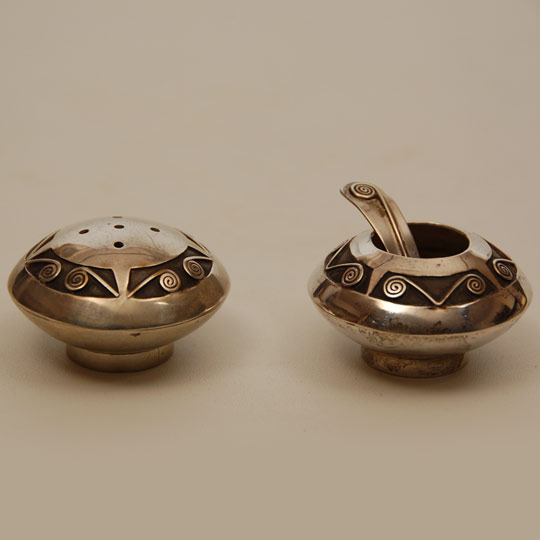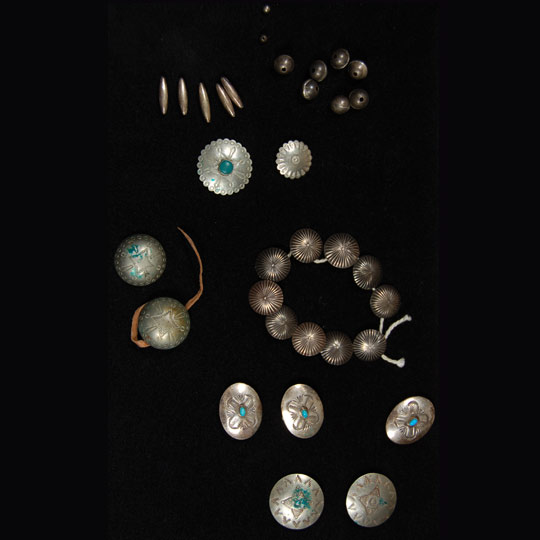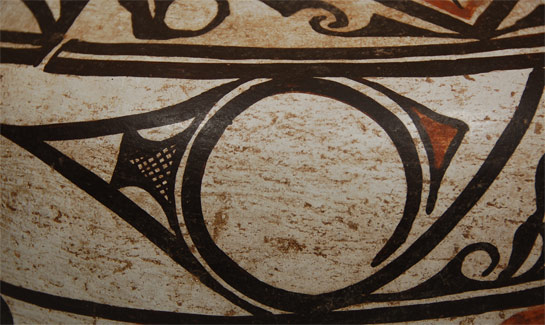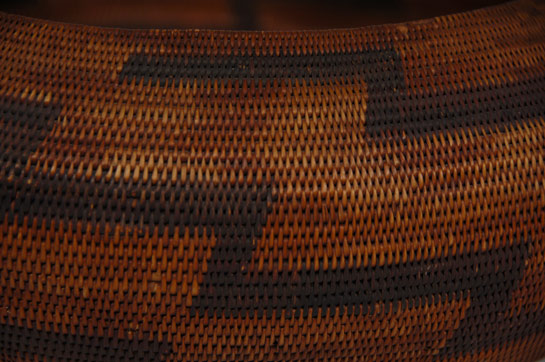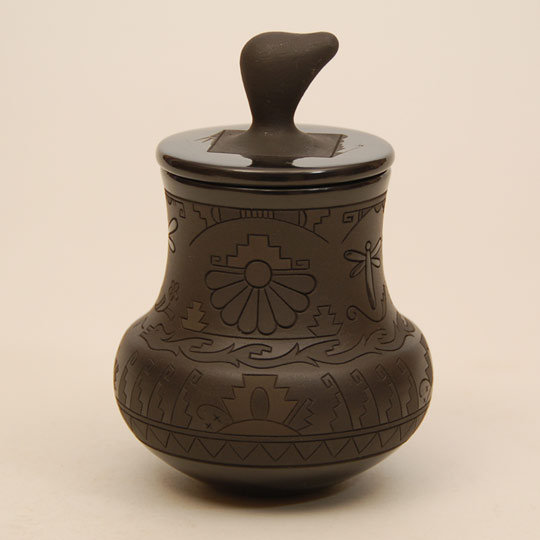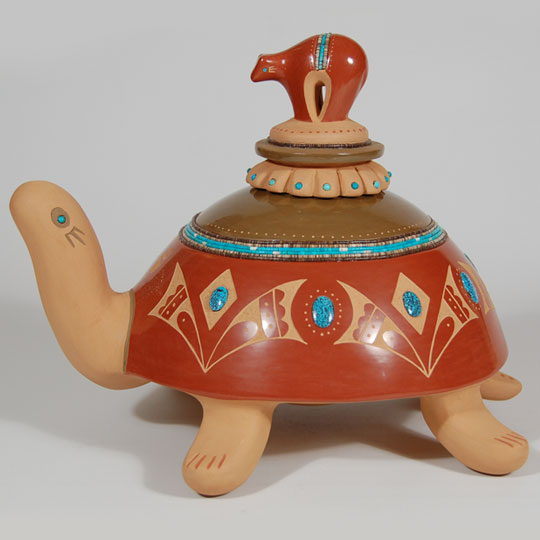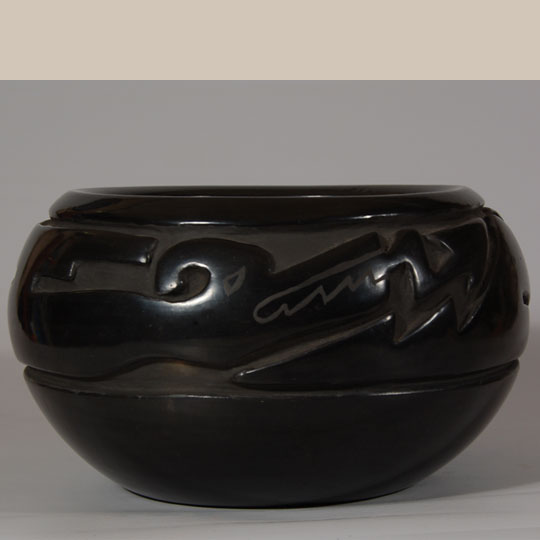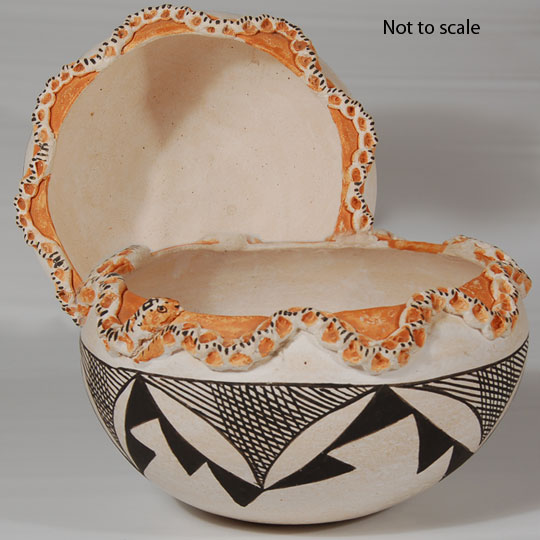Subject: San Ildefonso Polychrome Jar by Crucita Gonzales Calabaza (Blue Corn)
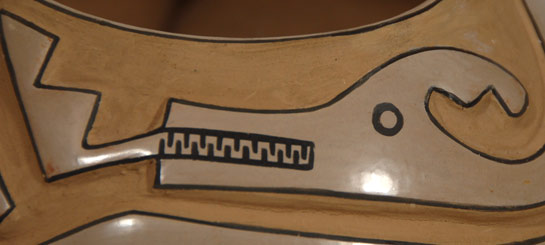
Blue Corn is responsible for reviving Polychrome pottery at San Ildefonso Pueblo. After Maria and Julian Martinez made the Black-on-black famous, the Polychrome wares faded into history. Blue Corn produced blackware and redware but her specialty was her beautiful Polychrome pottery.
This jar is not what one pictures when one thinks Polychrome, but technically it is comprised of three colors. A tan slip was applied to the upper portion of the vessel and left in a matte finish; a pewter slip was applied to the lower section and stone polished to a very high luster. Black outlining of the Avanyu and adjacent edges completed the third color.
The bowl is signed Blue Corn San Ildefonso Pueblo.
Condition: in very good condition.
Provenance: from a gentleman in Albuquerque
Reference and Recommended Reading: Pueblo Indian Pottery: 750 Artist Biographies by Gregory Schaaf
Subject: San Ildefonso Polychrome Jar by Crucita Gonzales Calabaza (Blue Corn)
Artist / Potter: Crucita Gonzales Calabaza (1921-1999) Blue Corn
Category: Contemporary
Origin: San Ildefonso Pueblo
Medium: clay, pigment
Size: 3-3/4" tall x 7-1/4" diameter
Item # C3369B
Subject: Bronze Sculpture Entitled "Hopi Conflict"
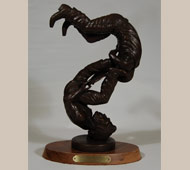 Each year Hopi women take part in a ceremony called the Basket Dance during which possessions of increasing value are discarded and fought over by a waiting crowd of male spectators. Objects of lesser importance, like tennis shoes or plastic dishware, are the first items to be thrown out. But as the dance progresses, the objects become more valuable. Woven baskets and plaques made by the women are the last to go and are fought over with the greatest intensity, as evidenced in the spinning combatants depicted in "Hopi Conflict."
Each year Hopi women take part in a ceremony called the Basket Dance during which possessions of increasing value are discarded and fought over by a waiting crowd of male spectators. Objects of lesser importance, like tennis shoes or plastic dishware, are the first items to be thrown out. But as the dance progresses, the objects become more valuable. Woven baskets and plaques made by the women are the last to go and are fought over with the greatest intensity, as evidenced in the spinning combatants depicted in "Hopi Conflict."
The original wood carving for this bronze was so precisely balanced that it stood independent of its base and was formed from one twisted piece of cottonwood root.
This limited edition bronze of Hopi artist Lowell Talashoma, Sr. is the manifestation of an artistic eye and vision that spans two cultures, for Lowell was unusual in having spent many of his childhood years in the care of foster parents who raised him in a mainstream American home. Becoming Hopi meant for Lowell Talashoma, Sr. accepting a new reality and set of beliefs as well as coming to understand the traditions, ceremonies, languages and social customs implicit in his choice. Giving form to this historically-rich culture was a task Lowell set for himself with pleasure and excitement, what is ancient and inherently true to the Hopi people was newly rediscovered and revered through Lowell's dawning awareness of what it was to be Hopi.
Each form and figure tells a story as does the process Lowell employed in its creation. His images were inspired by Hopi beliefs and were "liberated" from cottonwood root-the Hopi traditional carving material-through Lowell's vision of what lay within. Although he could have worked faster in preparation for bronzing by using wax or clay, Lowell preferred to interact with the wood, a material he respected for its life character. The castings made from his carvings via the lost wax method retain that spirit. Even the grain of the original wood can be discerned in the finished bronze.
Take notice in this bronze that the two Hopi young men are tussling over a Hopi basket, the most prized of all the thrown gifts during the basket dance.
This bronze of "Hopi Conflict" was cast in an edition of 35 of which this is number 1. It was completed in 1982.
Condition: original condition with slight abrasion to the wood pedestal
Provenance: from the estate of a California family
Subject: Bronze Sculpture Entitled "Hopi Conflict"
Artist: Lowell Talashoma, Sr. (1950-2003)
Category: Bronze
Origin: Hopi Pueblo
Medium: bronze casting, wood pedestal
Size: 12-1/2" tall including pedestal
Item # C3365D
Biography: Grace Chapella - White Squash Blossom (1874-1980)
Grace Chapella was born February 4, 1874, at the Tewa village of Hano at First Mesa on the Hopi Reservation. This was just a decade after the end of the Civil War, and two years before Custer's Last Stand at the Battle of the Little Big Horn. It was also eight years before the Reservation was established as such. She witnessed the first horseless carriage arrive on the Reservation and recalled how frightening it was. In 1927, she became the first person from Hopi Pueblo to fly in an airplane, going from the Grand Canyon to Long Beach for a pottery demonstration. Read more about Grace Chapella.
Subject: Pair of Salt and Pepper Containers
This set consists of a sterling silver salt cellar and serving spoon and a pepper shaker, all in the style of Navajo, or quite possibly Hopi silverwork. The workmanship is extraordinary with a top layer consisting of cutout designs imposed over a lower layer of smoke-colored silver backing. It is the overlay technique that makes us say it could be of Hopi origin.
Condition: original condition
Provenance: from the personal collection of Margaret Gutierrez, Santa Clara Pueblo
Recommended Reading: Masterworks and Eccentricities: The Druckman Collection; Navajo and Pueblo Jewelry and Metalwork 1880-1950 by Robert Bauver
Subject: Pair of Salt and Pepper Containers
Unknown Maker
Category: Silver Objects
Origin: Diné - Navajo Nation
Medium: sterling silver
Size: 1-1/8" tall x 1-7/8" diameter
Item # C3371E
Subject: Selection of Sterling Silver Buttons and Beads
This group is a mixture of shirt buttons, moccasin buttons and silver beads and cones. They are all sterling silver and, except for the shirt buttons, are handmade Navajo items. The shirt buttons may be of commercial manufacture.
Subject: Selection of Sterling Silver Buttons and Beads
Unknown Maker
Category: Buttons and Conchas
Origin: Diné - Navajo Nation
Medium: silver
Size: 1/8" to 1"
Item # C3371F
Subject: Pop Chalee Painting of Three Leaping Deer
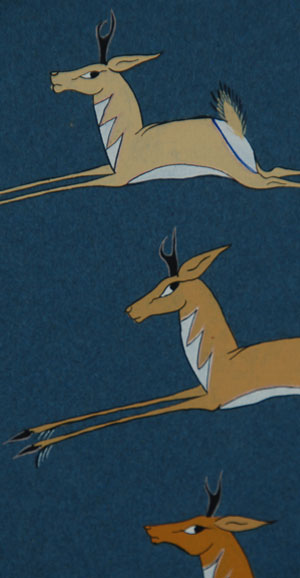 Pop Chalee was well known for her murals and was commissioned to do work for Marshall Fields in Chicago, Santa Fe Railroad Ticket Office in Santa Fe, New Mexico State Capitol Building, the Albuquerque Airport and the Grand Hotel on Mackinac Island. One of her most interesting works, which can still be seen today, is part of a mural commissioned for Maisel's Gallery on Central Avenue in downtown Albuquerque. In this piece she collaborated with other well-known artists Harrison Begay, Awa Tsireh, Joe Herrera and Pablita Velarde. Two of Pop Chalee's very large paintings hang in the Albuquerque International Airport.
Pop Chalee was well known for her murals and was commissioned to do work for Marshall Fields in Chicago, Santa Fe Railroad Ticket Office in Santa Fe, New Mexico State Capitol Building, the Albuquerque Airport and the Grand Hotel on Mackinac Island. One of her most interesting works, which can still be seen today, is part of a mural commissioned for Maisel's Gallery on Central Avenue in downtown Albuquerque. In this piece she collaborated with other well-known artists Harrison Begay, Awa Tsireh, Joe Herrera and Pablita Velarde. Two of Pop Chalee's very large paintings hang in the Albuquerque International Airport.
Blue Flower, as she is known, was praised for her whimsical interpretations of animal and forest scenes executed in bold, bright colors. She studied in the 1930s at the Santa Fe Indian School under the tutelage of Dorothy Dunn, whose influence is quite apparent in her work as she created traditional two dimensional scenes of animals and everyday pueblo life. However, she veered away from Dunn's more conservative interpretations of Native life with her use of color and fairytale-like creatures such as these three leaping deer.
Pop Chalee had her own style which has not been copied by any other Native artists. Her animals are lean and graceful and traditionally have long extended legs. These three leaping deer are outlined in black and painted in three different shades of tan. There is no ground plane or backdrop as is traditional with students of the Indian School. The half circle in upper right could be her interpretation of the moon. The single flowering plant in lower left is the extent of decoration. The painting is signed in lower right.
Condition: The painting is in original condition.
Provenance: from a major painting collector family of Arizona
Recommended Reading: The World of Flower Blue by Margaret Cesa
Subject: Pop Chalee Painting of Three Leaping Deer
Artist: Merina Lujan (1906-1993) Pop Chalee - Blue Flower
Category: Paintings
Origin: Taos Pueblo
Medium: casein
Size: 9-1/4" x 7" image; 15-3/4" x 13-1/2" framed
Item # C3267N
Subject: Cochiti Pueblo Silver and Turquoise Concha Belt
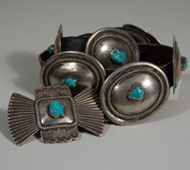 Joe Herrera Quintana was a very private person and, as a result, very little is known about his personal life, but he spent his adult life making jewelry for a number of stores and dealers. He worked for Gan's, Packard's and Simpson's stores in Santa Fe, and for Maisel's and The Covered Wagon in Old Town Albuquerque. Finally, he worked for Irma Bailey at Irma's Indian Arts & Pawn in Albuquerque from 1966 until she closed the shop in 1971. He then returned to Cochiti Pueblo where he continued making jewelry and drums and continued supplying Irma Bailey with jewelry. After he passed away, Bailey had a collection of over 600 items of Quintana's jewelry and silver works. In 2004, the Museum of Indian Arts & Culture in Santa Fe exhibited a large amount of this collection.
Joe Herrera Quintana was a very private person and, as a result, very little is known about his personal life, but he spent his adult life making jewelry for a number of stores and dealers. He worked for Gan's, Packard's and Simpson's stores in Santa Fe, and for Maisel's and The Covered Wagon in Old Town Albuquerque. Finally, he worked for Irma Bailey at Irma's Indian Arts & Pawn in Albuquerque from 1966 until she closed the shop in 1971. He then returned to Cochiti Pueblo where he continued making jewelry and drums and continued supplying Irma Bailey with jewelry. After he passed away, Bailey had a collection of over 600 items of Quintana's jewelry and silver works. In 2004, the Museum of Indian Arts & Culture in Santa Fe exhibited a large amount of this collection.
This belt contains 9 oval sterling silver conchas, each with a turquoise nugget at its center. A beautiful sterling silver buckle with rays spreading outward from the sides and stamped designs on the up and down ends. A turquoise stone sits in the middle of the buckle. The buckle is stamped JHQUINTANA COCHITI NM.
The belt fits waist sizes from 28 to 30, obviously designed for a petit person. Additional holes could be punched in the leather to expand the size to a maximum of 32 inches.
Condition: very good condition
Provenance: from the personal collection of Margaret Gutierrez, Santa Clara Pueblo
Recommended Reading: Joe H. Quintana Master in Metal: Selections from the Irma Bailey Collection, Museum of Indian Arts & Culture
Subject: Cochiti Pueblo Silver and Turquoise Concha Belt
Artist: Joe H. Quintana (1915-1991)
Category: Belts and Buckles
Origin: Cochiti Pueblo
Medium: sterling silver, turquoise, leather
Size: 2-3/8" x 1-7/8" each concha; 3" x 2" buckle
Item # C3371B
Subject: Popsicle Alabaster Sculpture of a Bear
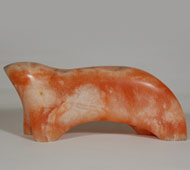 This very stylized sculpture of a bear was carved from Popsicle Alabaster that has a beautiful warm coral color and a fine polish. According to the owner, it dates to the mid-1980s. It is signed Haozous on the lower right leg.
This very stylized sculpture of a bear was carved from Popsicle Alabaster that has a beautiful warm coral color and a fine polish. According to the owner, it dates to the mid-1980s. It is signed Haozous on the lower right leg.
Bob Haozous is a Warm Springs Chiricahua Apache Indian and the son of famous sculptor Allan Houser. Haozous has major art sculptures in two dozen cities in the United States and Europe. He has been included in many exhibitions, numbering over two dozen. He is recognized as a major American Indian artist of the 20th century.
Condition: original condition except there may be a small abrasion on the bear's head.
Provenance: from the collection of Michael Hamilton, manager of the Case Trading Post, Wheelwright Museum in Santa Fe from 1978 to 1998.
Subject: Popsicle Alabaster Sculpture of a Bear
Artist: Bob Haozous (1943 - present)
Category: Stone
Origin: Apache
Medium: Popsicle Alabaster
Size: 5-1/4" tall x12-1/2" long x 3-1/4" wide
Item # C3375B
Subject: Tennessee Limestone Sculpture of an American Bison
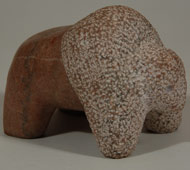 Bob Haozous is a Warm Springs Chiricahua Apache Indian and the son of famous sculptor Allan Houser. Haozous has major art sculptures in two dozen cities in the United States and Europe. He has been included in many exhibitions, numbering over two dozen. He is recognized as a major American Indian artist of the 20th century.
Bob Haozous is a Warm Springs Chiricahua Apache Indian and the son of famous sculptor Allan Houser. Haozous has major art sculptures in two dozen cities in the United States and Europe. He has been included in many exhibitions, numbering over two dozen. He is recognized as a major American Indian artist of the 20th century.
 This small American bison was carved from Tennessee limestone. The body of the bison is highly polished and the hair section was achieved by pecking at the stone with a sharp instrument. The sculpture is signed on the underside B Haozous. It is not dated. According to the owner, it dates to the mid-1980s.
This small American bison was carved from Tennessee limestone. The body of the bison is highly polished and the hair section was achieved by pecking at the stone with a sharp instrument. The sculpture is signed on the underside B Haozous. It is not dated. According to the owner, it dates to the mid-1980s.
Condition: original condition.
Provenance: from the collection of Michael Hamilton, manager of the Case Trading Post, Wheelwright Museum in Santa Fe from 1978 to 1998.
Subject: Tennessee Limestone Sculpture of an American Bison
Artist: Bob Haozous (1943 - present)
Category: Stone
Origin: Apache
Medium: Tennessee limestone
Size: 3-3/4" tall x 5" long x 3-1/2" wide
Item # C3375A
Biography: Asunción Aguilar Caté (1880–1925)
The Aguilar sisters—Asunción Aguilar Caté and Felipita Aguilar Garcia—and their sister-in-law, Mrs. Ramon Garcia, were exceptional potters in the late 19th and early 20th century period at Santo Domingo Pueblo (now Kewa Pueblo). They followed tradition in their early works in that designs on their pottery were typical strong black geometrics on creamy white slip. According to some records, sales of pottery of all potters drastically slowed around 1910 and Mr. Seligman, trader at the post at Santo Domingo, suggested they try developing something different to see if that would spur sales.
The women developed two styles of decorating: one was red and black with white outlining; the other was black with thin white outlining. It appears that Asunción Caté seemed to prefer the style using black and red, such as this one. The majority of the surface of her jars are painted with strong heavy black pigment and accented with white and red. In this case, the red is limited to lines outlining the black windows around the neck. Below the black mid-body is a traditional wiped-on red band over the base cream slip.
The new design creations by these women were not received with any fanfare at the time and apparently sales did not noticeably increase, however, in the late 20th century, their pottery was received with much enthusiasm by collectors and their enormous creativity has now been recognized. They certainly are among the innovators of 20th century potters along with Maria Martinez, Helen Cordero, Popovi Da, Tony Da and others who were true creators of something new. Read More..
Subject: Zuni Pueblo 19th Century Polychrome Olla with Capped Spirals
The primary design feature on this jar is what has been named capped spirals and it appears on Zuni pottery dating since 1850. In this jar, two capped spirals are joined by their long black line which results in a triangular effect. There are pairs of capped spirals in two rows on the main body separated by a series of orange birds with strong black eyes. The continuous band of orange birds is broken twice by placement of large medallion figures.
The neck design features the traditional daggers and hachured triangles seen on most Zuni jars of the late 1800s. The rim of the jar and base are painted black and a puki line is definitely discernible. The jar certainly dates to no later than 1880.
There have always been strict guidelines at Zuni Pueblo regarding pottery decoration, yet each potter has also always had some degree of freedom. The things that seem to be traditional and inflexible are the manner in which the main body decoration and that of the neck are separated. According to Zuni informants to Ruth Bunzel in 1924 and 1925, it is imperative that the first bit of decoration that goes on any Zuni jar be the black framing line or pair of framing lines that separate the neck from the main body. It is also imperative that this line or pair of lines not be connected. Today we refer to this as a ceremonial break. The informants were explicit in these statements.
Another noticeable aspect on Zuni jars is that there is no correlation between the design of the neck and that of the body of the vessel, except that a certain harmony is preserved between the two. The preferred neck decoration seems to be that shown on this olla. It consists of two designs and they are always used together. One of the designs has a diamond as its center, which represents the bird sling used by boys. The extended parts of this element with the crooks and hachured lines represent the face painting of the Newekwe society. The primary part of the second design around the neck is the triangular arrowhead-looking element that the Zuni women call the thunder knife which the priests use in many ceremonies. Another interesting observation is that the neck of the vessel is generally of the same height as the black underbody of the jar.
Traditionally, the body of the vessel is divided into three horizontal bands-two of which are wide and one narrow. Placing medallions at designated spots, as in this jar, frequently breaks up these horizontal bands; however, that further emphasizes the horizontal nature of the design. There are two medallions on this jar and both are simpler in style that medallions of the post-1900 period.
The upper and lower bands on this jar are of unequal width and feature mirror image designs, however, the design in the lower panel is executed in smaller scale due to the shape of the vessel. According to Bunzel, the spiral designs used in the upper and lower bands of a jar will never be used in any other position, such as the neck. Neck designs and body designs are not interchangeable. The spirals here were described to Bunzel as representing the drumstick used by fraternities in their ceremonies in prayers for rain.
A band of red birds, each with black legs and a black dot for an eye, separates the two bands of spirals. The birds are not outlined in black. The use of red elsewhere in the design of the jar is outlined in black, as in the triangles and the medallions.
This jar evidences a puki bulge at the underbody and a prominent ridge at the base of the neck. The base is concave and the rim exhibits a definite lip. It is an excellent example of a 19th century Zuni jar with designs that precede the now-popular deer designs.
Condition: very good condition for a jar of this age. There is some rim abrasion, probably from use as a water jar and ladle.
Reference: The Pueblo Potter: A Study of Creative Imagination in Primitive Art by Ruth Bunzel. Columbia University, New York.
Provenance: formerly the property of a family from Gallup, NM who departed the area in mid-20th century.
Recommended Reading: The Pottery of Zuni Pueblo by Lanmon and Harlow
Subject: Zuni Pueblo 19th Century Polychrome Olla with Capped Spirals
Potter Unknown
Category: Historic
Origin: Zuni Pueblo
Medium: clay, pigment
Size: 10-3/4" tall x 13-1/2" diameter
Item # C3376
Subject: Pomo 19th Century Storage Basket
Storage baskets of this style were the largest baskets made by the Pomo Indians. The Pomo women made these large, globular baskets to hold any variety of objects in the home-acorns, treasures, clothing and anything else they wished to store and protect. Interestingly, larger baskets of this nature were given to the new groom by his mother-in-law as a "dowry basket." The Pomo word for this style basket is Chimo (literally, "son-in-law"). This basket is a small storage basket and not of the scale of the largest ones made which could be approaching three feet in diameter.
The Pomo occupied the Pacific coast from just south of the Russian River north to the Fort Bragg area and from the ocean inland to just east of Clear Lake. The Pomo did not have a government reservation. It is estimated that their aboriginal population was as high at 8000 but was down to around 1200 by 1910. Earlier Pomo baskets are very rare because traditionally baskets were burned with their maker. Fortunately, that tradition ended.
Condition: very good condition with only a very few missing stitches and one broken foundation rod.
Provenance: ex coll Florsheim family of Milwaukee, WI
ex coll of a family from Asheville, NC
Reference Materials:
Native American Basketry of Central California by Christopher L. Moser
The Fine Art of California Indian Basketry by Brian Bibby
Subject: Pomo 19th Century Storage Basket
Weaver Unknown
Category: Bowls and Other Forms
Origin: Pomo
Medium: split sedge root, willow foundation
Size: 4-1/2" deep x 12-1/4" diameter
Item # C3373
Subject: Navajo (Diné) Folk Art Wood Carving "Lady in Yellow with Coke Can"
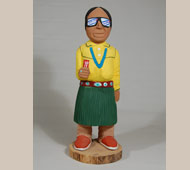 Harrison Juan describes the inspiration for his innovative and distinctive current style as follows: "I was at an art show and I saw myself in the sunglasses of a collector, and I got the idea of carving people wearing glasses like that. I could capture their likeness and place them in their environment all at one time."
Harrison Juan describes the inspiration for his innovative and distinctive current style as follows: "I was at an art show and I saw myself in the sunglasses of a collector, and I got the idea of carving people wearing glasses like that. I could capture their likeness and place them in their environment all at one time."
Juan is a nephew of folk art artist Johnson Antonio and remembers cutting wood for his uncle and running errands for him. It was his influence that was the motivation for Juan to start carving. He works from cottonwood he finds along the creek beds of the San Juan River. It is his hope to work full time as an artist, but has found it necessary to work construction jobs as well.
"I just try to keep it going," the artist explains, "showing the joys of reservation life and Navajo people at gatherings, ceremonies, and just the fun of friends being together at local posts. I carve the older people and show how they are dressed (wrapped in colorful trade blankets, sometimes called Pendleton's, and sporting their best jewelry)." Many are wearing his signature sunglasses. Captured in their reflection are groups of neighbors and friends and perhaps a glimpse of clear Western skies and surrounding scenery of the reservation.
This carving of a Navajo woman with her green pleated skirt and bright yellow blouse is shown holding a can of Coca Cola while in her sunglasses is a reflection of Pepsi. She is wearing a concha belt, a two-strand turquoise nugget necklace and traditional moccasins. The carving is signed by the artist on the underside and was completed in the 1980s.
Condition: original condition
Provenance: from the collection of Jan and Chuck Rosenak.
Recommended Reading: Navajo Folk Art by Chuck and Jan Rosenak
Subject: Navajo (Diné) Folk Art Wood Carving "Lady in Yellow with Coke Can"
Artist / Carver: Harrison Juan (1953-present)
Category: Other Items
Origin: Diné - Navajo Nation
Medium: wood, paint
Size: 15-3/8" tall x 5-1/2" diameter of base
Item # C3347H
Subject: Navajo (Diné) Folk Art Wood Carving "Evil Pleasures"
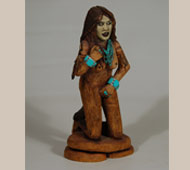 This sculpture is of a Female Skinwalker, which, in Navajo legend, would be much rarer than a male Skinwalker. There are several varieties of Navajo witches, one of which is using his (rarely her) powers to travel in animal form. In some versions, men or women who have attained the highest level of priesthood are called "pure evil."
This sculpture is of a Female Skinwalker, which, in Navajo legend, would be much rarer than a male Skinwalker. There are several varieties of Navajo witches, one of which is using his (rarely her) powers to travel in animal form. In some versions, men or women who have attained the highest level of priesthood are called "pure evil."
They are human beings who have gained supernatural power by breaking a cultural taboo. Specifically, a person is said to gain the power to become one upon initiation into the Witchery Way. Both men and women can become skinwalkers, but men are far more numerous. It is generally thought that only childless women can become witches.
Larry Jacquez (pronounced Hackus) is a Navajo folk art carver who specializes in the unusual. He is known to have carved and painted extraordinary objects, accurately depicting the Yeis, Navajo mythology, and the dances and escapades of skinwalkers. The Rosenaks stated that they were surprised by the appearance of skinwalkers in his work, and doubtful of their very existence, but Jacquez told them that "evil witches do exist."
Some Navajo also believe that skinwalkers have the ability to steal the "skin" or body of a person. The Navajo believe that if you lock eyes with a skinwalker, they can absorb themselves into your body. It is also said that skinwalkers avoid the light and that their eyes glow like an animal's when in human form, and when in animal form their eyes do not glow as an animal's would. Some Navajos believe that if you make eye contact with a skinwalker, your body will freeze up due to the fear of them and they then use that fear as energy against the person.
A skinwalker is usually described as naked, except for an animal skin. Some Navajos describe them as a mutated version of the animal in question. The skin may just be a mask, like those which are the only garment worn in the witches' song.
This carving of a female skinwalker is naked as skinwalkers are thought to be. She has the body, from the waist down, of an animal including a tail. She is elaborately decorated with turquoise jewelry. Her face is painted a ghostly white.
This carving is signed on the underside "Evil Pleasures" Navajo female skinwalker '01 L. Jacquez.
Condition: very good condition with only one string on the right bicep partially missing.
Provenance: from the collection of Jan and Chuck Rosenak
Recommended Reading: Navajo Folk Art by Chuck and Jan Rosenak
Referenced Material: the information on female skinwalkers was excerpted from the online source of Wikipedia.
Subject: Navajo (Diné) Folk Art Wood Carving "Evil Pleasures"
Artist / Carver: Lawrence Jacquez (1965- )
Category: Other Items
Origin: Diné - Navajo Nation
Medium: wood, paint
Size: 9" tall x 4-3/8" diameter of base
Item # C3347B
Subject: Santa Clara Matte Black Lidded Jar
Dolores Curran, originally from Santa Clara Pueblo, married and moved to Ohkay Owingeh Pueblo around 1977. She has specialized in miniature pottery since her first piece at age 9. Her designs are each original to the piece of pottery on which she is working. She does not record her designs because she doesn't want to start copying herself. She prefers to fit each design to the pot on which it goes.
This exquisite small jar is a miniature version of a storage jar. The exception to that would be the lid as a standard storage jar would generally not have a lid. In her incomparable fashion, she reversed the normal pattern of burnishing the entire jar and then painting a design in matte paint. Here she has left the entire jar in matte finish except for the burnished rim and base and the top of the lid. Her designs were carved with the utmost care and precision. Dolores stated that she applies as many as five coats of slip to each design. In her scale of work, she is unmatched by any others.
Dolores Curran and Geri Naranjo are sisters and both work in miniature scale. Dolores's daughter, Ursula Curran, also makes miniature pottery. The entire family is very talented.
Condition: new
Provenance: from the potter through an intermediary
Recommended Reading: Pueblo Indian Pottery: 750 Artist Biographies by Gregory Schaaf
Subject: Santa Clara Matte Black Lidded Jar
Artist / Potter: Dolores Curran
Category: Contemporary
Origin: Santa Clara Pueblo
Medium: clay
Size: 3-3/4" tall without lid; 5-1/4" tall with lid; 3-3/4" diameter
Item # C3369E
Subject: Male Storyteller with 5 Children made by Alma Concha
Alma Concha is one of six Loretto sisters originally from Jemez Pueblo. Her sisters are Mary Toya, Fannie Loretto, Lupe Lucero, Edna Coriz and Dorothy Trujillo. She began learning the techniques of making pottery as a child and has continued during her adult life. Her first storyteller was made in 1969 after she married and moved to Taos Pueblo.
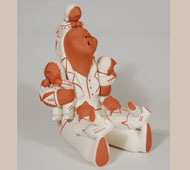 Her style of storyteller figurines and nacimientos may be classified as minimalist in that there are few decorations on the figures. The natural orange clay used for the base structure is covered with cream clay paint for clothing and hair. The faces are without eyes and sometimes without mouths-resulting in the most minimalist of features. This is a style developed completely by Alma and not copied by others. This storyteller was made in 2003.
Her style of storyteller figurines and nacimientos may be classified as minimalist in that there are few decorations on the figures. The natural orange clay used for the base structure is covered with cream clay paint for clothing and hair. The faces are without eyes and sometimes without mouths-resulting in the most minimalist of features. This is a style developed completely by Alma and not copied by others. This storyteller was made in 2003.
Alma has been known as Alma Loretto, Alma Concha, and now, Alma Maestas. In 1979, she was a part of the landmark Albuquerque Museum exhibit "One Space: Three Visions." Three years later, she was included in an article in National Geographic Magazine.
Condition: original condition. It appears that Alma left a fingerprint on the right side of the head of one of the children. That's as good as a signature! Generally, if a potter touches the clay before firing, a fingerprint, which is not visible at the time, will reveal itself after firing.
Provenance: from the collection of Jeffrey Trent of Las Vegas, NV
Recommended Reading: The Pueblo Storyteller by Barbara Babcock
Subject: Male Storyteller with 5 Children made by Alma Concha
Artist / Potter: Alma Concha (1941 - present)
Category: Figurines
Origin: Jemez Pueblo
Medium: native clay
Size: 8-1/2" Tall
Item # C3310K
Subject: San Ildefonso Multi-colored Turtle Figurine
Innovation by the small population of potters at San Ildefonso Pueblo is a well-established fact. Maria Martinez could be the first considered to be a true innovator. Having been accustomed to producing, with her husband Julian, traditional San Ildefonso Pueblo Polychrome pottery, she easily took to experimenting and producing blackware in the 1920s and 1930s. Maria's and Julian's son Popovi Da continued the family penchant for innovation when he experimented with sienna ware and inserting turquoise into pottery in the 1960s. His son, Tony Da, took the whole idea of innovation to the limit when he created his masterpieces of pottery during his short career.
The potter Blue Corn also was an innovator. After blackware became the predominant pottery production at the pueblo, she singly reintroduced traditional Polychrome wares. Rose Gonzales introduced the carved pottery style to the pueblo. Tse-Pé Gonzales may have been the first to introduce green slip to black pottery. It goes on and on. I am sure there are others who have slipped my mind at this time.
Today, the indisputable true innovator at San Ildefonso is Russell Sanchez. An innovator in pottery styles but a traditionalist in pueblo culture and life style. Russell is a strict disciplinarian when teaching the younger generation the dances and religious customs of the pueblo to the point that he says the young ones fear him and yet respect him.
When making pottery, Russell stretches the envelope to incorporate ideas from his fertile mind. He says, when some question his strict adherence to tradition in life styles but innovation when it comes to pottery, that his pottery is traditional in every phase of manufacture but contemporary in style and creativity. There is no conflict.
This turtle was begun by Sanchez two years ago. It is the third one he tried and the first of this scale to succeed. He worked on it slowly, letting his mind mature on it as he selected style, slip, and techniques. He discovered, by the time he got to this one, how to keep it from destroying in the firing process. As non-potters, most of us do not realize the talent and knowledge potters must possess to be successful. Proper clay, proper temper, and proper techniques all contribute to success as do talent and creativity.
The selection of green and red slips, the finest of turquoise and shell hieshe, and the absolutely beautiful turquoise cabs add immeasurably to the overall appeal of the figurine. The fan-like designs on the body are traditional San Ildefonso designs from the earlier Polychrome wares. Just above the neck of the turtle, in the red slip, what appear to be needle-point pricks in the slip actually represent sacred corn meal.
Turtles have a place in pueblo mythology, as do bears. In this instance, the bear represents the pueblo people and the turtle is rescuing them, a legend shared by several pueblos. The inclusion of the bear and the sacred cornmeal design signify the significance of the figurine as a serious traditional item of religious intent rather than simply an art object. All pueblo items that are considered as art objects by non-natives are considered as religious or ceremonial by pueblo peoples. From the first step in gathering clay for pottery, the potters thank Mother Earth and offer sacred cornmeal for her giving them the clay. This thought is carried forth throughout the entire process. There is no term for art in the native languages. Pueblo pottery has always carried a religious significance to the potters and still does today even if the size and style do not lean themselves to traditional use as did the older pottery.
This turtle is absolutely flawless and magnificent. I was overwhelmed when Sanchez brought it to the gallery. The scale, design, execution and beauty are just beyond belief. His pride in completing it after two years of work was quite evident when he unwrapped it at the gallery. Our compliments go to Russell Sanchez for such a monumental object.
Condition: new
Provenance: from the artist
Recommended Reading: Art of Clay: Timeless Pottery of the Southwest by Lee. M. Cohen
Subject: San Ildefonso Multi-colored Turtle Figurine
Artist / Potter: Russell Sanchez (1966-present)
Category: Contemporary
Origin: San Ildefonso Pueblo
Medium: clay, turquoise, hieshe
Size: 10" long x 8-1/4" wide x 8" tall
Item # 25554
Subject: Santa Clara Pueblo Black Carved Bowl with Avanyu
Starting sometime in the 1950s, Margaret Tafoya made smaller bowls, such as this one, for sale to tourists visiting the pueblo as well as to take to Royal Gorge for the summer. Margaret and her family spent their summers-from Memorial Day to Labor Day-at the Royal Gorge near Canon City, Colorado, selling pottery and entertaining the tourists with dances and permitting them to photograph the family members-all for a fee. She had made enough pottery before going to Royal Gorge to take with her to sell. She did not make pottery on site.
It was during the 1950s that pueblo pottery underwent a revival in interest by collectors and tourists. Following the lean years of World War II, both from a buyer's standpoint and that of the seller as well, the 1950s saw a renaissance. Americans had sacrificed during the war, skimping and saving for the war effort and now gasoline and tires were again available and travel was possible.
The Southwest was once again of interest and New Mexico saw a tremendous influx of tourists willing and anxious to purchase souvenirs to take back home. Fortunately for the pueblo potters, there was great interest in their pottery.
This medium size black carved bowl is typical of many that found their way out of the Southwest and into collections from coast to coast. It is a marvelous jar and is beautifully designed.
Condition: The jar is in really outstanding condition for a piece of its age. There are no significant scratches and no chips or any other damage. It is signed Margaret Tafoya on the underside.
Provenance: from a gentleman in Albuquerque
Recommended Reading: Born of Fire: The Pottery of Margaret Tafoya by Charles King
Subject: Santa Clara Pueblo Black Carved Bowl with Avanyu
Artist / Potter: Margaret Tafoya 1904-2001
Category: Contemporary
Origin: Santa Clara Pueblo
Medium: clay
Size: 5-3/8" tall x 9-1/2" diameter
Item # C3233A
Subject: Zia Pueblo Polychrome Canteen with Zia Bird Design
Water-carrying canteens have been made by the pueblo people for several hundred years, long before the arrival of Europeans. Interestingly enough, the shape of canteens has changed very little in this time. Apparently, the users were quite satisfied with the vessel shape as it was.
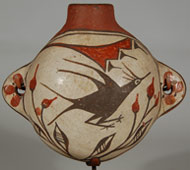 The design field is slipped in a creamy white slip on which is prominently displayed a wide-eyed Zia bird above which is a red design that could represent rain clouds. A single flower sprouts up in two branches below the bird. Two handles are on the sides of the body, pierced to provide for lacing a leather strap through.
The design field is slipped in a creamy white slip on which is prominently displayed a wide-eyed Zia bird above which is a red design that could represent rain clouds. A single flower sprouts up in two branches below the bird. Two handles are on the sides of the body, pierced to provide for lacing a leather strap through.
It appears that the canteen is as old as the 1930s but a date cannot be absolutely stated. It is not signed, but the matte wiped-on red band below the design panel is indicative of an earlier age when pottery was not signed by the maker. A metal stand has been fabricated to permit the canteen to be displayed in a forward facing position.
Condition: the handle on the right side of the canteen has been broken off and glued back in place in a very professional manner and the break is not easily noticeable.
Provenance: from the collection of a Santa Fe resident
Recommended Reading: The Pottery of Zia Pueblo by Francis Harlow and Dwight Lanmon
Subject: Zia Pueblo Polychrome Canteen with Zia Bird Design
Potter Unknown
Category: Contemporary
Origin: Zia Pueblo
Medium: clay, pigment
Size: 6" tall x 7" wide x 3-1/2" deep
Item # C3364B
Subject: Acoma Pueblo Bowl with Appliqué Rim
This exquisite Acoma Pueblo bowl is signed with the initials of the potter and not revealing a first name. I have been unable to locate a potter with these initials. The only one is Annie Cerno, whose real name is Santana Cimmeron Cerno, the mother of Joseph Cerno. Since there is no middle initial of "L" in her name, I doubt she is the potter of this bowl.
Regardless, the bowl is truly well made, finely painted, and has a serpent in appliqué around the rim. Quite often, appliqué attachments do not adhere well to the body of the vessel, but an experience potter knows how to achieve the near to impossible task.
Condition: original condition
Provenance: from the Katherine H. Rust collection
Recommended Reading: Acoma & Laguna Pottery by Rick Dillingham
Subject: Acoma Pueblo Bowl with Appliqué Rim
Artist / Potter: Potter Unknown
Category: Contemporary
Origin: Acoma Pueblo
Medium: clay, pigment
Size: 3-3/4" deep x 6-1/2" diameter
Item # C3235H


